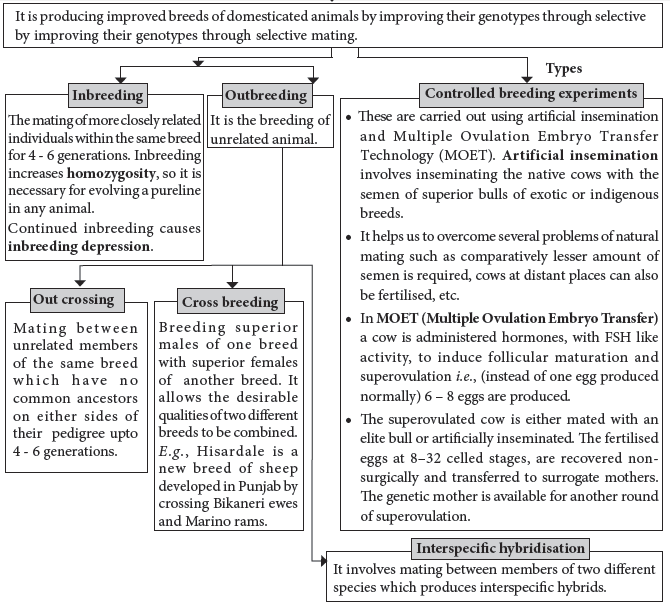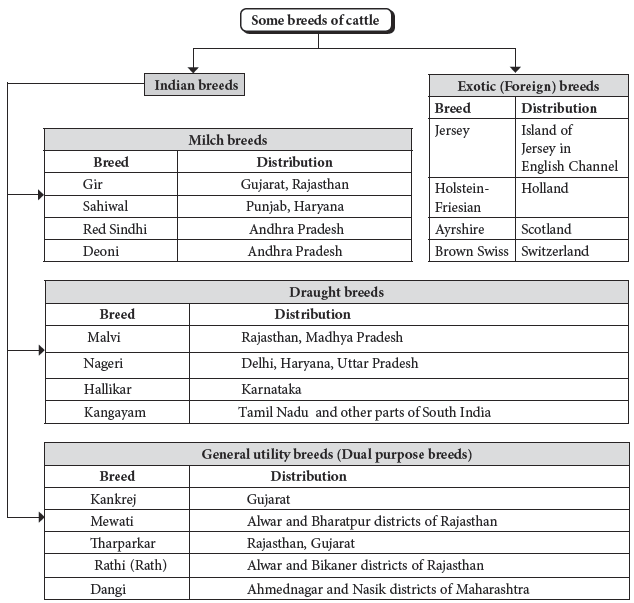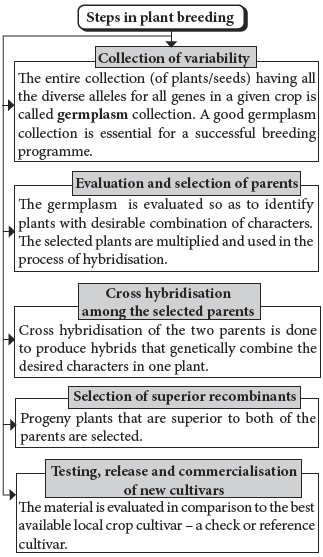Download CBSE Class 12 Biology Strategies For Enhancement In Food Production Notes Set B in PDF format. All Revision notes for Class 12 Biology have been designed as per the latest syllabus and updated chapters given in your textbook for Biology in Class 12. Our teachers have designed these concept notes for the benefit of Class 12 students. You should use these chapter wise notes for revision on daily basis. These study notes can also be used for learning each chapter and its important and difficult topics or revision just before your exams to help you get better scores in upcoming examinations, You can also use Printable notes for Class 12 Biology for faster revision of difficult topics and get higher rank. After reading these notes also refer to MCQ questions for Class 12 Biology given on studiestoday
Revision Notes for Class 12 Biology Chapter 9 Strategies for Enhancement In Food Production
Class 12 Biology students should refer to the following concepts and notes for Chapter 9 Strategies for Enhancement In Food Production in Class 12. These exam notes for Class 12 Biology will be very useful for upcoming class tests and examinations and help you to score good marks
Chapter 9 Strategies for Enhancement In Food Production Notes Class 12 Biology
ANIMAL BREEDING
• Animal husbandry is the science of systematic breeding and raising of domesticated animals as per human requirement.
• Animal breeding aims at increasing the yield of animals and improving the desirable qualities of the produce.

Dairy farm management
It is the management of animals for obtaining milk and other milk products for human consumption. It deals with processes and systems that increase yield and improve quality of milk. Dairy animals include cow, buffalo, goat etc.

Poultry farm management
Poultry is the class of domesticated fowl (birds) used for meat and eggs. They typically include chicken and ducks, and sometimes turkey and geese. Poultry birds exclusively grown for meat are called broilers (e.g., Plymouth Rock), layers are female fowls for egg production, cockerel is a young male fowl and rooster is a mature male fowl. Pullet is young hen of less than one year. Selection of disease free and suitable breeds, proper and safe farm conditions, proper feed and water, hygiene and health care are important components of poultry farm management.
Apiculture
• Apiculture or bee keeping is care and management of honey bees. Common species of honey bee are – Apis dorsata (rock bee), Apis indica (Indian bee), Apis florea (little bee), and Apis mellifera (Italian bee). All of them occur in nature as wild insects.
• However, because of their high economic importance, the honey-bees, especially, A. mellifera is domesticated, reared and bred in artificial hives.
• Honeybees also produce beewax, which finds many uses in industry, such as in the preparation of cosmetics and polishes of various kinds.
• Knowledge of the nature and habits of bees, selection of suitable location for keepingthe beehives, catching and hiving of swarms (group of bees), management of beehives during different seasons, and handling and collection of honey and beewax are important for successful bee keeping.
Sericulture
• Sericulture is the rearing of silkworms (i.e., production of cocoons) for commercial production of silk. though a number of silk producing species are known but only few species are used for sericulture like Bombyx mori, Antheraea paphia, Antheraea assama and Attacus ricinii.
• India is the fourth largest producer of raw silk in the world. Raw silk is used in many ways – in the manufacture of woollen and knitted garments, parachute components, fishing lines, elastic webs, bolting silk cloth used in milling and chemical industry, insulation coils of telephone and wireless receivers.
Fisheries
• Fishery is an industry devoted to the catching, processing or selling of fish, shellfish or other aquatic animals. A large section of our population is dependent on fish, fish products and other aquatic animals such as prawn, crab, lobster, oyster, etc., for food.
• Aquaculture is rearing and management of useful aquatic plants and animals like fish, oysters, mussels, prawns, etc. Pisciculture is rearing, catching and management of fish. This has led to the development and flourishing of the fishery industry, and it has brought a lot of income to the farmers in particular and the country in general.
• Fisheries are divided into two types -marine and freshwater.
Common edible fishes of India
PLANT BREEDING
• Plant breeding is the genetic improvement of the crop in order to create desired varieties of plant types that are better suited for cultivation, give better yields and are disease resistant.
• Classical plant breeding includes hybridisation (crossing) of pure lines, and selection of progeny plants to get plants with desirable characters of higher yield, nutrition and resistance to diseases.

• The development of several high yielding varieties of wheat and rice in the mid-1960s, as a result of various plant breeding techniques led to dramatic increase in food production in our country. This phase is often referred to as the Green Revolution.
• Conventional breeding is often constrained by the availability of limited number of disease resistance genes. Other breeding methods that are used are mutation breeding, selection amongst somaclonal variants and genetic engineering.
• It is possible to induce mutations artificially through use of chemicals or radiations (like gamma radiations), and selecting and using the plants that have the desirable character as a source in breeding-this process is called mutation breeding. In mung bean, resistance to yellow mosaic virus and powdery mildew were induced by mutations.
Breeding for improved food quality
• Breeding of crops with high levels of vitamins and minerals or higher protein and healthier fats is called biofortification and is the most practical aspect to improve the health of the people.
• Plant breeding is undertaken for improved nutritional quality of the plants with the objectives of improvement in : protein content and quality, oil content and quality, vitamin content and micronutrient and mineral content.
• Indian Agricultural Research Institute (IARI), New Delhi, has also developed many vegetable crops that are rich in minerals and vitamins.
SINGLE CELL PROTEIN (SCP)
• Conventional agricultural production of cereals, pulses, vegetables, fruits, etc., may not be able to meet the demand of food at the rate at which human and animal population is increasing.
• One of the alternate sources of proteins for animal and human nutrition is single cell protein (SCP). It is dried cell of microorganisms or microbes (algae, bacteria, actinomycetes and fungi) used as food.
• The term SCP does not indicate its actual meaning because the biomass is not only obtained from unicellular organisms but also from multicellular organisms.
• Microbes like Spirulina can be grown on waste water from potato processing plants (containing starch), straw, molasses, animal manure and even sewage, to produce food rich in proteins, minerals, fat, carbohydrates and vitamins.
• SCP is rich in high quality protein and is poor in fats.
• It has been estimated that a 250 kg cow produces 200 g of protein per day. In the same period 250 g of a microorganism like Methylophilus methylotrophus because of its high content of biomass production and growth, can produce about 25 tonnes of protein.
TISSUE CULTURE
• Plant tissue culture is an in vitro technique of maintaining and growing plant cells, tissues or organs aseptically on artificial medium in suitable containers under controlled environmental conditions. The part which is cultured is called explant.
• Cellular totipotency is the ability of a somatic cell/explant to produce the complete organism. The explants are treated with specific antimicrobial chemicals to make them free from microbes. Culture media containing inorganic salts, certain vitamins, sucrose (as a source of carbon and energy) and the desired growth regulators is provided that is required for the desired growth and development of the explants.
• Embryoids are nonzygotic or somatic embryolike structures which are produced by in vitro culture and have the ability to form full fledged plants.
• Producing thousands of plants through tissue culture is called micropropagation. Each of these plants will be genetically indentical to the original plant from which they are grown, i.e., they are somaclones. Many important plants like tomato, banana, apple, etc., have been produced on commercial scale using this method.
• Steps in micropropagation include initiation of culture from an explant on a suitable nutrient medium, shoot formation from the explant, rooting of in vitro developed shoots, hardening of plantlets and transplantation to fields.
• Depending upon the type of explant, tissue culture is called meristem culture, multiple shoot culture, anther/haploidculture, embryo culture, ovule culture, etc.
• On the basis of in vitro growth, plant tissue cultures are of two types, callus and suspension cultures.
• In callus culture, cell division in explant forms a callus. Callus is irregular unorganised and undifferentiated mass of actively dividing cells.
• A suspension culture consists of single cells or small groups of cells suspended in a liquid medium containing the auxin 2,4–D. Suspension cultures grow much faster than callus culture.
Protoplast culture and somatic hybridisation
• When a hybrid is produced by fusion of somatic cells of two varieties or species, it is known as somatic hybrid. The process of producing somatic hybrids is called somatic hybridisation.
• First, the cell wall of the plant cells are removed then the protoplasts of the two plants are brought in contact and made to fuse by means of electrofusion or chemicals like polyethylene glycol (PEG) and sodium nitrate. The fused protoplasts soon develop their own walls and then they are called somatic hybrid cells.
• Successful somatic hybrids have also been got from different species of Brassica, Petunia and Solanum. Pomato is somatic hybrid between potato and tomato that belong to two different genera.
• Protoplast technology has opened up avenues for development of hybrids of even asexually reproducing plants. Somatic hybrids may be used for the production of useful allopolyploids.
• Genetic mainipulations can be carried out more rapidly when plant cells are in protoplast state. New genes can be introduced (e.g., male sterility, herbicide resistance). Mutations will be easier.
| CBSE Class 12 Biology Human Reproduction Minds Map |
| CBSE Class 12 Biology Human Reproduction Notes Set A |
| CBSE Class 12 Biology Human Reproduction Notes Set B |
| CBSE Class 12 Biology Reproductive Health Notes Set A |
| CBSE Class 12 Biology Reproductive Health Notes Set B |
| CBSE Class 12 Biology Evolution Minds Map |
| CBSE Class 12 Biology Evolution Notes Set A |
| CBSE Class 12 Biology Evolution Notes Set B |
| CBSE Class 12 Biology Microbes In Human Welfare Notes Set A |
| CBSE Class 12 Biology Microbes In Human Welfare Notes Set B |
| CBSE Class 12 Biology Biotechnology Principles And Processes Notes Set A |
| CBSE Class 12 Biology Biotechnology Principles And Processes Notes Set B |
| CBSE Class 12 Biology Biotechnology And Its Application Notes Set A |
| CBSE Class 12 Biology Biotechnology And Its Application Notes Set B |
| CBSE Class 12 Biology Organisms And Populations Notes Set A |
| CBSE Class 12 Biology Organisms And Populations Notes Set B |
| CBSE Class 12 Biology Ecosystem Notes Set A |
| CBSE Class 12 Biology Ecosystem Notes Set B |
| CBSE Class 12 Biology Biodiversity And Conservation Notes Set A |
| CBSE Class 12 Biology Biodiversity And Conservation Notes Set B |
CBSE Class 12 Biology Chapter 9 Strategies for Enhancement In Food Production Notes
We hope you liked the above notes for topic Chapter 9 Strategies for Enhancement In Food Production which has been designed as per the latest syllabus for Class 12 Biology released by CBSE. Students of Class 12 should download and practice the above notes for Class 12 Biology regularly. All revision notes have been designed for Biology by referring to the most important topics which the students should learn to get better marks in examinations. Our team of expert teachers have referred to the NCERT book for Class 12 Biology to design the Biology Class 12 notes. After reading the notes which have been developed as per the latest books also refer to the NCERT solutions for Class 12 Biology provided by our teachers. We have also provided a lot of MCQ questions for Class 12 Biology in the notes so that you can learn the concepts and also solve questions relating to the topics. We have also provided a lot of Worksheets for Class 12 Biology which you can use to further make yourself stronger in Biology.
You can download notes for Class 12 Biology Chapter 9 Strategies for Enhancement In Food Production for latest academic session from StudiesToday.com
Yes, the notes issued for Class 12 Biology Chapter 9 Strategies for Enhancement In Food Production have been made available here for latest CBSE session
There is no charge for the notes for CBSE Class 12 Biology Chapter 9 Strategies for Enhancement In Food Production, you can download everything free of charge
www.studiestoday.com is the best website from which you can download latest notes for Chapter 9 Strategies for Enhancement In Food Production Biology Class 12
Come to StudiesToday.com to get best quality topic wise notes for Class 12 Biology Chapter 9 Strategies for Enhancement In Food Production

